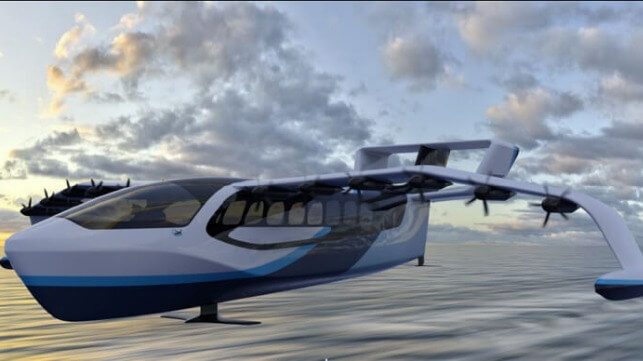THE JETSONS GO JET SURFING
USCG Clears Regent’s Wing-in-Ground Craft for Full-Scale Human Testing

The application of wing-in-ground technology is a step closer to reality as the U.S. Coast Guard approved the application from Regent, a manufacturer of the craft, to test its full-scale prototype including with humans on board. This comes just two years ago Regent successfully proved its WIG approach called a Seaglider using a quarter-scale prototype.
Regent promotes the Seaglider as a sustainable form of maritime mobility combining the speed of an aircraft with the convenience of a boat. It can be used for coastal transportation replacing regional aircraft and as a new form of ferry. The concept has drawn strong interest from airlines with Japan Airlines and Lockheed Martin among the investors. Mitsui O.S.K. Lines became an investor and Brittany Ferries is exploring using the craft for its service across the English Channel.
The first design is for an all-electric 12-passenger vessel that can travel at 180 mph. It would have a range of 180 miles on a single charge of its batteries. The company also looks to a larger 100-passenger version as battery technology advances.
Because WIG crafts operate skimming the water and within one wingspan of the surface, U.S. law treats them as maritime vessels. As such, the regulation is led by the U.S. Coast Guard with technical support from the Federal Aviation Administration.
“U.S. Coast Guard approval of REGENT’s Navigational Safety Risk Assessment marks a significant step in bringing us closer to seaglider prototype testing with humans on board,” said Ted Lester, VP, of Certification, Regent.
The company reports the USCG formally accepted its Navigation Safety Risk Assessment with no modifications. The assessment included a third-party risk analysis of navigational safety and a review of environmental concerns and economic impacts from testing. Regent says it consulted more than 20 local stakeholders, including the Rhode Island Department of Environmental Management, harbor masters, marine pilots, the U.S. Navy, the Federal Aviation Administration, sailing organizations, and environmental groups, to ensure their concerns were addressed.
After review at the sector, division, and national level, the U.S. Coast Guard issues its approval. The company believes this assessment and approval will also act as a model for future commercial seaglider approvals in other U.S. waterways and around the globe.
With the approval, Regent will proceed toward its full-scale prototype tests. They previously completed float, foil, and flight tests with the smaller prototype. They plan to start testing the full-scale version later this year with humans aboard. They are approved for Narragansett Bay and Rhode Island Sound. The first flight is planned for early next year.
Regent has previously said its target is to bring the first commercial model to market by mid-decade. The company reports over 600 orders valued at more than $9 billion from airline and ferry operators.
No comments:
Post a Comment